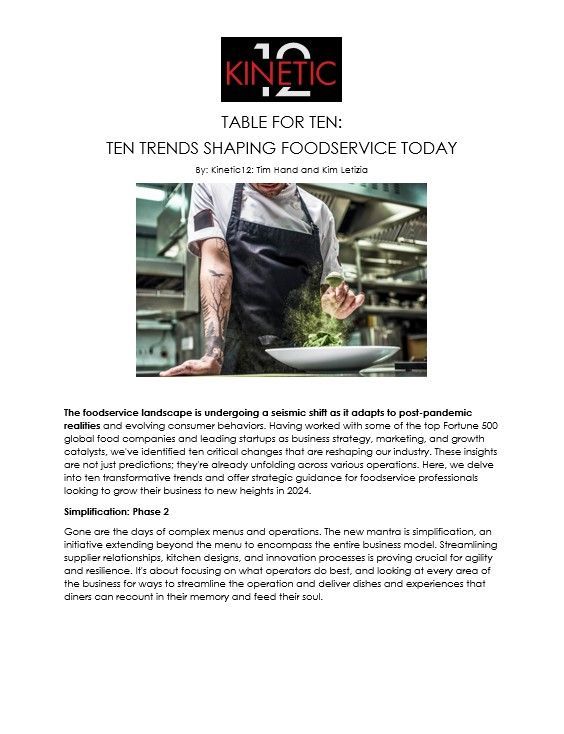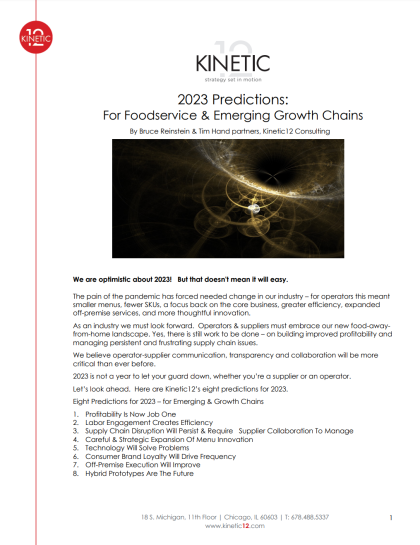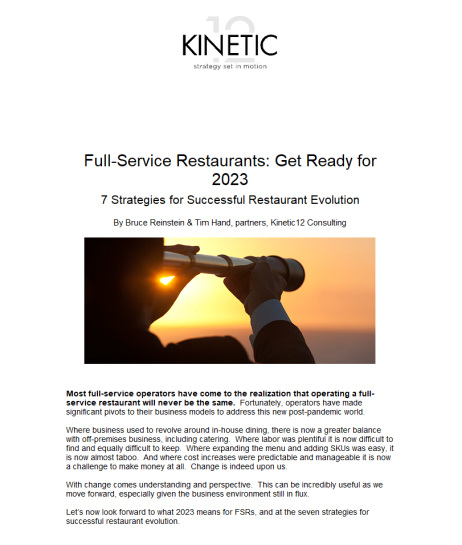2025 Predictions: Elevating Foodservice in a New Era
"The future belongs to those who believe in the beauty of their dreams," Eleanor Roosevelt once said. In 2025, the foodservice industry stands poised to make those dreams a reality, not through small steps but by daring to reimagine what’s possible. This is our moment to think bigger, act bolder, and reshape how we connect with consumers in ways that inspire loyalty and ignite imaginations.
The rules have changed. Consumers demand flexibility, authenticity, and seamless engagement across every channel. The question isn’t if we adapt –it’s how we lead.
This year, success will belong to those who transform challenges into opportunities: redefining hospitality not as a place, but as an experience, meeting consumers wherever they are, and turning every interaction –digital or physical –into a moment that matters.
Real change requires more than innovation –it demands collaboration. Operators and suppliers must unite to build solutions that address today’s realities while shaping tomorrow’s possibilities. Together, we have the chance to craft an industry that doesn’t just serve but inspires, creating a future in which foodservice transcends expectations and redefines its impact on the world.
The following 10 predictions from Kinetic12 outline the key areas where transformation will happen, offering a roadmap for how operators and suppliers can seize the opportunities ahead.
1. Guest-Centricity as the North Star
What’s Different in 2025: Consumers expect more than quality food and efficient service –they demand personalized, purpose-driven experiences that resonate emotionally.
Key Focus Areas:
- Elevated Hospitality: Reinvent in-store experiences with high-touch interactions and surprise-and-delight moments that build emotional loyalty.
- Omnichannel Excellence: Ensure seamless integration between digital and physical touchpoints to create a unified customer journey.
- Purpose-Driven Branding: Align offerings with consumer values, such as sustainability and inclusivity, to differentiate and build trust.
2. The Next Frontier: Integrated Experiences
What’s Different in 2025: The future of foodservice lies in blurring the boundaries between dining, retail, and entertainment. Restaurants are no longer just places to eat –they are hubs of community, experiences, and even commerce. Operators must embrace a hybrid model that combines experiential dining with new revenue streams like branded products, content creation, and immersive events.
Key Focus Areas:
- Restaurant as a Destination: Transform locations into spaces where customers come not just for food but for memorable experiences –live music, cooking classes, or curated retail offerings.
- Brand Extensions: Leverage the brand’s identity to create new products like packaged sauces, meal kits, or co-branded retail items that can be sold in-store and online.
- Immersive Dining: Experiment with sensory-driven dining experiences, from augmented reality (AR) menus to theatrical meal presentations that turn dining into entertainment.
3. Optimizing the Virtual Customer Relationship
What’s Different in 2025: With approximately 60% of dining now off-premise, the customer relationship has shifted to a digital-first dynamic. Operators must rethink how they foster meaningful connections in this virtual environment.
Key Focus Areas:
- Digital Loyalty Programs: Build relationships beyond transactions with virtual rewards, exclusive online perks, and gamified engagement.
- Social Connection: Leverage social media and online platforms to create two-way conversations and drive engagement.
- Consistency Across Channels:
Ensure that the virtual experience mirrors the quality and personalization of in-store dining.
4. Tactics to Combat Traffic Declines
What’s Different in 2025: The focus is shifting from forcing customers into physical locations to meeting them wherever they choose to engage –be it at home, on their phones, or through delivery services. Operators must prioritize organic demand creation through modern tools like social media, influencer partnerships, and frictionless digital experiences. It’s not just about pricing and LTOs anymore, it’s about thinking more holistically about the complexity of the human experience and the emotional connection to the brand beyond the four walls.
We need to think at a higher level to meet the current consumer where they’re at.
Key Focus Areas:
- Social Media as a Traffic Driver: Use platforms like TikTok, Instagram, and YouTube to create viral moments around menu items, stories, or campaigns that resonate with target demographics.
- Off-Premise Appeal: Offer exclusive off-premise perks, such as bundled meals, limited-time delivery-only items, or loyalty points tied to digital orders.
- Community-Centric Marketing: Build brand affinity by participating in or hosting community events, partnering with local creators, or highlighting causes that matter to your audience.
5. Profitability Through Creativity
What’s Different in 2025: Operators are moving beyond traditional cost-cutting to focus on creative solutions that drive both revenue and margins.
Key Focus Areas:
- Diversification: Expand into catering, retail products, and subscription models to grow beyond traditional revenue streams.
- Smart Efficiency: Leverage tech-enabled solutions to optimize labor, reduce waste, and streamline operations.
- Co-Creation with Suppliers: Develop menu items and operational strategies that align with profitability goals while enhancing guest experiences.
6. Technology as a Seamless Ecosystem
What’s Different in 2025: Technology adoption has evolved from isolated solutions to fully integrated ecosystems that enhance every aspect of the business.
Key Focus Areas:
- Integrated Systems: Connect front-of-house and back-of-house operations for seamless workflows and consistent execution.
- Digital Guest Tools: Implement predictive ordering, automated loyalty programs, and AI-driven insights to elevate the customer experience.
- Operational Agility: Use technology to rapidly adapt to shifting consumer preferences and operational challenges.
7. Collaboration as the New Currency
What’s Different in 2025: Supplier-operator relationships are evolving from transactional to transformational, with a focus on long-term partnerships.
Key Focus Areas:
- Proactive Communication: Provide early visibility into supply chain challenges and collaborate on solutions.
- Shared Innovation: Work together to solve systemic issues like labor shortages, sustainability, and traffic declines.
- Holistic Support: Align with operator goals across culinary, marketing, and operational teams to maximize impact.
8. Sustainability as a Business Imperative
What’s Different in 2025: Sustainability is no longer a "nice-to-have." It is essential to both operational efficiency and consumer loyalty.
Key Focus Areas:
- Operational Sustainability: Reduce waste, prioritize local sourcing, and adopt energy-efficient practices to improve environmental impact.
- Consumer Trust: Transparently communicate sustainability initiatives to strengthen guest loyalty.
- Sustainability as Profitability: Use sustainable practices to reduce costs while creating value for customers and stakeholders.
9. Labor Transformation Through Engagement
What’s Different in 2025: Labor strategies are evolving to focus on holistic employee well-being, career growth, and inclusivity.
Key Focus Areas:
- Employee Empowerment: Train and recognize employees to deliver high-quality guest interactions while fostering a positive workplace culture.
- Tech-Human Integration: Automate repetitive tasks to free staff for higher-value guest engagement.
- Culture of Care: Create workplaces where employees feel valued, supported, and motivated to excel.
10. Innovation Led by the Consumer
What’s Different in 2025: The modern consumer wants flexibility and connection, and innovation must revolve around meeting these needs. Rather than creating innovation for innovation’s sake, operators are focusing on blending convenience with moments of delight, using digital tools and off-premise strategies to remain relevant in consumers' daily lives.
Key Focus Areas:
- Digital-First Innovation: Develop app-exclusive features, such as gamified loyalty programs, augmented reality menu previews, or customizable meal options that cater to the individual.
- Content-Driven Engagement: Create compelling social content that inspires action –think behind-the-scenes videos, storytelling about sourcing, or collaborations with influencers that reflect the brand’s values.
- Seamless Off-Premise Experiences: Redesign packaging and delivery processes to ensure food quality, branding, and convenience stand out as differentiators.
Leading in 2025
“The best way to predict the future is to create it,” Abraham Lincoln famously said. In 2025, this industry has the tools, talent, and drive to turn that vision into action. This is our year to step beyond the status quo and lead with imagination, purpose, and courage.
The opportunities ahead are boundless. Technology gives us the power to engage like never before. Collaboration fuels solutions that transform obstacles into advantages. Innovation, driven by the needs of consumers, allows us to design experiences that are unforgettable, accessible, and authentic.
But this future won’t build itself. It demands leadership that is unafraid to break the mold and forge new paths. It requires operators and suppliers to work together not just as business partners, but as co-creators of a new reality for foodservice --one that reflects the lives, values, and aspirations of the people we serve.
2025 isn’t just another year –it’s a blank canvas, waiting for bold ideas and fearless action.
About Kinetic12: Kim Letizia, Tim Hand, and Art Bell are with Kinetic12 Consulting, a Chicago-based Foodservice and general management consulting firm. The firm works with leading Foodservice suppliers, operators, and organizations on customized strategic initiatives, as well as guiding multiple collaborative forums and best practice projects. They also engage as keynote speakers at operator franchise conferences and supplier sales meetings. Their previous leadership roles in restaurant chain operations and at Foodservice manufacturers provide a balanced industry perspective.
Contact us to learn more about how we can help your organization through customized consulting or through participating in our Emerging & Growth Chains program.



